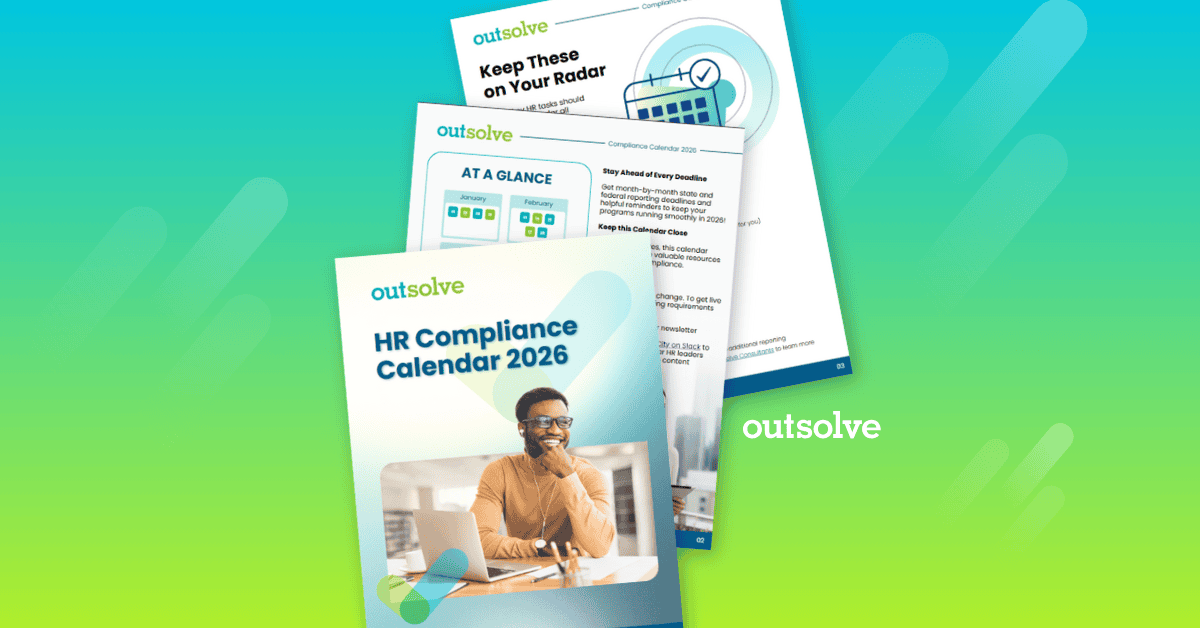5 min read
State Pay Data Reporting Requirements: What You Need to Know
 Bryan Ishmael
:
Jun 18, 2025 9:49:00 AM
Bryan Ishmael
:
Jun 18, 2025 9:49:00 AM

If you’re in Human Resources (HR) and your company operates in multiple states, then chances are your plate is already full trying to keep up with the various federal employment and state specific laws. As if that wasn’t enough, there’s yet another emerging compliance initiative that you need to keep on your radar, which is state pay data reporting requirements.
Over the last few years, states have increasingly introduced laws around promoting pay equity, transparency, and fair employment practices, and they’re expecting you to do the legwork to support and prove compliance. Several states have also introduced processes and requirements around pay data reporting.
If you’re wondering where to begin or how to stay ahead, then you’ve come to the right place. Here’s three key takeaways you’ll learn in this article:
- What’s driving pay data reporting
- Which states have already enacted these laws and key provisions of the law
- How HR can prepare and stay compliant
Why Pay Data Reporting Is on the Rise
One of the main objectives of pay data reporting is identifying and addressing pay disparities, particularly those based on gender, race, and ethnicity. States continue to enhance their own reporting pay laws because federal efforts, like EEO-1 Component 2 data collection, have not always been collected on a continual basis.
So, what are some of the goals of pay data reporting? They include increasing transparency in compensation, encouraging accountability within companies, and allowing government agencies to flag and address potential discrimination.
It’s important to note that, as with many employment-related regulations or reporting requirements, there are penalties for noncompliance, ranging from hefty fines to reputational damage. Bottom line is that compliance is not optional, nor is it something to leave until the last minute, so being proactive makes all the difference.
States with Pay Data Reporting Requirements
Let’s get into the details of pay data reporting requirements by state. Currently, California, Illinois, Massachusetts, and Minnesota all have pay data reporting requirements.
Here’s what HR needs to know:
California Pay Data Reporting
Portal: California Pay Data Reporting Portal (CRD)
- Covered Employers: Private employers with 100 or more employees (with at least one employee in California) must report annually. Private employers with 100 workers hired through a labor contractor who have at least 1 employee in California are also required to submit a separate Labor Contractor Report.
- Required Data: Employee counts by race, ethnicity, and gender across various job categories. If you use labor contractors, then you also need to report pay data on those workers.
- Deadlines: Reports are due annually by the second Wednesday in May (Tentatively May 13, 2026, for next year).
- Filing Process: Data must be submitted through the Civil Rights Department’s online portal. No paper filings accepted.
- Penalties: Civil penalties up to $200 per employee for failure to report.
- Why Enacted: California leads the way in equity-focused legislation. This law supports the state’s broader effort to address wage gaps and promote transparency.
Illinois Pay Data Reporting
Portal: IDOL Equal Pay Registration Certificate (EPRC)
- Covered Employers: Companies with 100+ employees in Illinois that are also required to file an EEO-1 report.
- Required Data: Employee demographic and compensation data, along with an Equal Pay Compliance Statement signed by a corporate officer.
- Deadlines: Employers are notified by IDOL of their required submission date, generally every two years. Many employers filed by March 24, 2024, when the first major round was due.
- Filing Process: Submit data via the Illinois Department of Labor portal.
- Penalties: Fines of up to $10,000 for failure to obtain a certificate.
- Why Enacted: Illinois’ Equal Pay Act aims to eliminate wage disparities and holds employers accountable for proving equal pay practices.
Massachusetts Pay Data Reporting
Portal: Massachusetts Pay Equity Tools
- Covered Employers: Reporting is now mandatory for employers in MA who had 100 or more employees at any time in the prior calendar year and are already subject to federal EEO disclosures (either EEO-1, EEO-3, EEO-4 or EEO-5 reporting requirements.
- Required Data: Employers must report workforce demographic by race, ethnicity, sex, and job category.
- Deadlines: First report was due on February 1, 2025, and annually thereafter every February 1.
- Filing Process: Employers file through MA’s portal (referenced above). Reports are accepted in PDF, JPG or PNG format.
- Penalties: Penalties may include a warning for the first offense, a maximum fine of $500 for the second offense, and a maximum fine of $1,000 for the third offense. Further violations could be subject to civil fines of $7,500 to $25,000, depending on the violation.
- Why Enacted: Massachusetts wants to continue its overall pay equity efforts around transparency. This builds on some of their previous voluntary tools and is consistent with national trends on pay reporting. In 2018, Massachusetts passed the Massachusetts Equal Pay Act (MEPA), which aimed to promote pay equity by prohibiting employers from asking about a candidate's salary history. While MEPA did not require employers to submit pay data reports at that time, it laid the groundwork for future legislation focused on pay transparency.
Minnesota Pay Data Reporting
Website: Minnesota Equal Pay Certificate
- Covered Employers: Applies to businesses with 40+ full-time employees who are bidding on state and municipal, contracts worth $500,000 or more.
- Political subdivisions: (e.g. municipalities, counties, or school districts) using state money for capital projects must comply if contracts exceed $1,000,000.
- Required Data: Equal Pay Certificate application, which contains a statement of compliance and details how compensation is reviewed by the contractor to ensure compliance.
- Deadlines: Certificate must be valid prior to contract award and renewed every four years.
- Filing Process: Submit application through the state and make an online payment of $250 on the state’s website.
- Penalties: Ineligibility to bid on or renew contracts; possible fines for misrepresentation.
- Why Enacted: This law targets state and local contractors to make sure that taxpayer dollars go to businesses that prioritize fair pay practices.
Key Challenges for Multi-State Employers
Now, let’s talk about reality in your daily work as it relates to pay data reporting. If you're managing compliance across multiple states, then you know it's not just about “checking a box.” Here’s some of the top challenges for HR:
- Data Collection Across Systems: Employee data usually resides in different silos, such as payroll, HRIS, and time tracking, so aligning them is not always as easy as it sounds.
- Different Reporting Requirements and Deadlines: No two states ask for exactly the same thing or at the same time. That means customized processes and not a one-size-fits-all approach if you operate in multiple states.
- Accuracy and Consistency: Inconsistent job classifications or demographic data can trigger red flags or penalties.
How to Prepare and Stay Compliant
The good news? With a proactive approach, HR can stay ahead of the curve. Here are some steps you can take now:
- Conduct Internal Audits: Regularly review your pay practices to uncover and address disparities before regulators do. This also helps improve trust with employees.
- Leverage Compensation and HR Software:The right tools can automate much of the heavy lifting and logistics, like aligning data formats, generating reports, and flagging potential issues or inconsistencies.
- Stay Informed on Regulatory Changes: As you know, state laws evolve and change quickly. Subscribe to alerts from your state labor department, join HR associations, and set Google Alerts for legislative updates. Sign up for OutSolve's newsletter to get updates delivered to your Inbox each week.
- Partner with Compliance Experts: If internal resources are stretched thin, consider hiring a consultant or legal advisor. They can help review and strengthen your reporting, so you’re covered in all areas. Our expert consultants at OutSolve are prepared and ready to help you.
What State Pay Data Reporting Requirements Mean for Your Organization
Regardless of what state you’re in, being proactive when it comes to preparing pay data reporting beats being reactive. Every. Single. Time.
Getting ahead of state requirements isn’t just about avoiding penalties. They also present an opportunity for businesses to strengthen their employer brand by demonstrating commitment to fair pay practices. In today’s competitive talent market, that matters more than ever for attracting and retaining top talent.
Need help with your pay data reporting process or managing compliance? Our team at OutSolve offers consultations, solutions, and expert guidance to simplify your reporting process. Let’s work together so we can help you take the stress out of compliance.
Bryan has a Bachelor of Science degree in Business Administration from The Citadel Military College of South Carolina. Bryan has over 11 years of experience in the HR Compliance field and has worked for OutSolve since 2022. As a Senior Consultant, Bryan develops anti-discrimination plans and consults his clients on Federal, EEO and State reporting regulations.
Weekly OutLook
Featured Posts

New Year, New Deadlines: 2026 HR Compliance Calendar

outRageous HR: Plan Now or Pay Later
Related Posts

In-House or Outsourced I-9 Management: Which Is Best for Your Organization?
Every U.S. employer, regardless of size or industry, is required by law to confirm each new hire’s identity and verify that they are authorized to...

outRageous HR: Building a Compensation Strategy That Actually Works
If your compensation strategy is mostly “gut feeling” plus whatever you did last year… it’s time to rethink your approach.

HR Compliance Checklist: What Every HR Pro Needs to Know
During times of sweeping change to federal laws, and with new state laws being enacted, it's more important than ever for HR professionals to ensure...